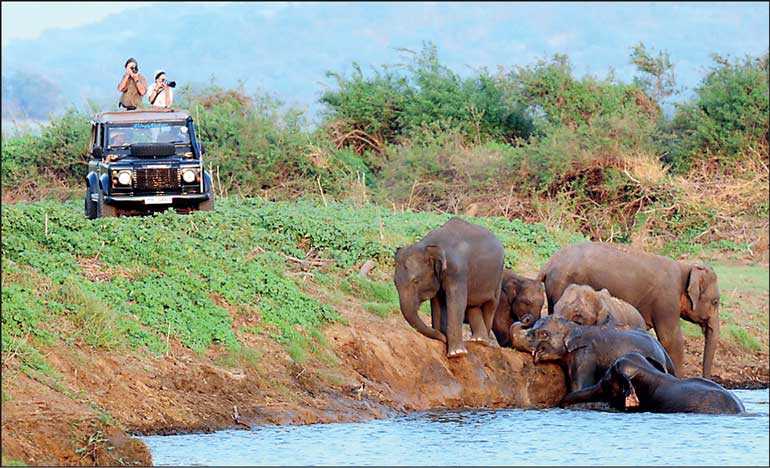Saturday Dec 06, 2025
Saturday Dec 06, 2025
Thursday, 29 April 2021 00:00 - - {{hitsCtrl.values.hits}}

 Historical perspectives
Historical perspectives
Tourism in Sri Lanka was recognised as an important new industry back in the 1960s. The industry was formalised through the Sri Lanka Tourist Board (SLTB) Act No. 10 of 1966 to promote tourism in Sri Lanka, and subsequently augmented by the Tourist Development Act No. 14 of 1968.
This framework was adequate during the formative stages of tourism. However, with tourism fast developing into a globally competitive industry, there was the need for more strategic thinking and direction to be given to the industry. Professional marketing strategies were required to compete in the world tourism market.
Private sector participation
The growth of Sri Lankan tourism could not keep pace with other competitive destinations as a result of internal strife. The strategic direction for Sri Lanka tourism remained in the hands of the Government, with little or no participation from the private sector.
However, it was the private sector who had the professionals with better understanding of the business, as opposed to the career administrative Government officers who were at the helm of the SLTB.
The private sector itself was clamouring for more involvement in driving the industry forward, due to their increasing involvement and investment in the industry.
World tourism
With world tourism growing at over 4% per annum (at the time), and South Asia in particular showing exceptional growth, it was imperative that Sri Lanka presented a new image to the world and quickly catch up.
Sri Lanka urgently needed to re-position and re-brand as an upmarket destination, which would attract better quality tourists, which in turn would drive up receipts and hasten growth.
The private sector was also quite convinced that they should be a part of the decision-making system, in terms of marketing and promoting the destination. (This is a concept followed by many other leading Asian destinations.)
The birth of the new Act
In this backdrop, more than a decade ago the private sector initiated the idea of a separate Tourism Authority, which would be vested with the power to manage, promote and develop tourism in Sri Lanka, and one where the private sector would play a lead role in partnership with the Government.
Successive Governments discussed this proposal with all stakeholders, and after a long and arduous process of many years, a final draft of the new tourism act was agreed upon by all stakeholders.
Consequently, this draft was gazetted on 16 September 2005 and the new Tourism Act No. 38 was presented to Parliament in November 2005. It subsequently came into operation in 2007.
It was noteworthy that this legislation was unanimously approved in Parliament, something very rarely seen in Sri Lankan politics.
The current Act at a glance
The new Act No. 38 of 2005 provided for the establishment of separate independent bodies having their own board of directors comprising private sector professionals and Government representatives, to manage different aspects of the tourism industry.
The new act provided for the establishment of the following new entities:
Each of these bodies would have:
Funding for the new framework
It was proposed to establish a Tourism Development Fund (TDF) which was to be funded by:
For this purpose, a Finance Act was instituted which provided the modalities for the collection of the funds needed from the private sector directly, to make the new Tourism Act work.
The funds thus collected were to be disbursed amongst the four institutions on a fixed ratio.
It was evident that this laid the foundation for a strong public-private partnership (PPP), and was hailed as a landmark initiative at that time.
So, what is wrong with the present Act?
The concerns raised currently are:
There is no question that there is some truth in that Sri Lanka is still unable to clearly position itself as a major player in world tourism, however, it is wrong to lay all the blame for this on the prevailing system.
It is evident that except for a few brief periods, the act was not properly implemented as envisaged.
Ad hoc appointments
There were long periods when the respective posts MD/DG of a particular institution were not filled, and the chairman played an executive role. At other times, persons thoroughly unsuited for the position were appointed (political patronage). Many changes of chairman took place at the whims and fancies of the Government. In many instances, the boards of the entities were not properly constituted, with several vacancies left unfilled.
Within these 14 years there have been 11 chairmen of the SLTDA – with only one serving a three-year term – and six director generals. It is the same with the other three institutions as well.
Government regulations and bureaucracy
The Tourism Act clearly provided the framework for operations similar to any private sector organisation. Once the annual plan and budget had been approved by the boards, it was the responsibility of the CEO/MD/DG to ensure that the plans were carried out. The incumbents were to be experienced and knowledgeable professionals capable of giving leadership. The chairman was to play a more non-executive role.
However, the basic operations still came under Government regulations (administrative and financial regulations). Hence, there was a clear disconnect with what was expected and the practical ground realities. Therefore, board decisions often could not be implemented.
The impact of the private sector
There is no doubt that the industry is led by the private sector, with the formal sector making the largest investment. In January 2020 there were 24,451 rooms in the formal sector (various star classes). Based on studies done, if the current replacement value of this room stock is calculated on a cost per room basis for each star class, the total investment is close upon $ 5.6 billion – without land value (close upon 6% of Sri Lanka’s GDP).
Therefore, with such a large stake in the economy of this country, it is quite justifiable that the formal sector should have a greater say in the affairs of tourism (in any organisation, the majority shareholders have larger representation).
This though by no means takes away the tremendous impact that the informal sector has played in the recent years in the development of tourism.
Duplication of operational aspects
Certainly, there could be some duplication of back-of-the-house operations within the four institutions. When the Act was implemented, no clear study was done as to how to allocate the staff to each of the institutions efficiently.
Rectification of this would be a simple task of undertaking a detailed work study and re-assessing the distribution.
So, the way forward?
It is evident that the existing Act provides adequate framework for an excellent PPP. After some 14 years in operation, certainly there could be some identified operational issues. That does not call for the entire Act to be replaced.
What is needed is for all parties to discuss the prevailing Act, identify the existing shortcomings and make necessary course corrections to address these issues.
If such a process is not followed, and a new Act instituted unilaterally, over a decade of hard work will be destroyed, and we would just be ‘throwing the baby out with the bathwater’.